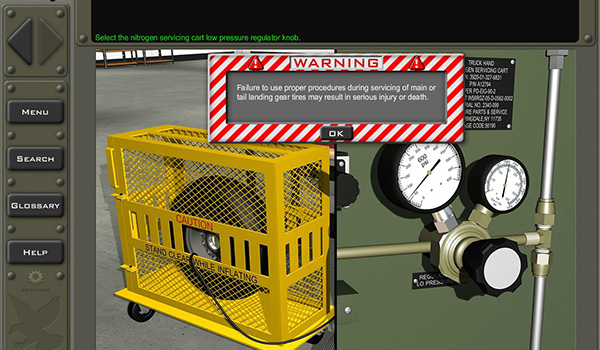
128th Aviation Brigade / By SGM Martin J. Moreno: The 128th Aviation Brigade is continually improving institutional training with key stakeholders and specialists ensuring instruction maintains fidelity to the Army Learning Concept. Group-style, course-based learning was effective in the past, but today’s Army consists of Soldiers and civilians that rely on learner-centric adaptive learning techniques.

Screenshot of UH-60M interactive training, an example of a digital maintenance training module that exists and is currently being used in the 15T10 UH-60 Helicopter Repairer Course./ 128TH AVN BDE GRAPHIC
To meet these demands, courses at the 128th AB are being developed with increased facilitation, interaction, and incorporation of technologies, such as interactive media and virtual interactive environments, which support different learning styles. A new initiative for automated testing for each of the battalions under the 128th AB supports this learning concept. The next step is to increase training capacity beyond the brick and mortar construct, to include tailored learning and instructional delivery at the point of need for continued maintainer training and education.
Self-Development Training
The 128th AB understands the importance of building lifelong learners. The creation of digital maintenance training modules that provide college credit and simulations that support Federal Aviation Administration licensure will provide needed training while incorporating self-development. Some obstacles to distance learning include long development timelines, limited ability to update contractor provided material, and lack of instructor training. In order to make sustainable progress, resolutions or workarounds to these issues must be established and executed.
Operational Training
Supporting the Aviation Enterprise is very important. The school is responsible for producing and distributing learning or training products to facilitate reach-back knowledge and information needed by operational units. With increasing complexities in unit missions and career paths, making sustainment training available to individuals for execution when it is needed by leveraging technology will help maintain operational proficiency. An example of how we can improve the traditional training model while supporting the operational domain would be the creation of simulations for uncommon repairs. Such a technology shared via a training management system that can provide a certification of training could facilitate repair approvals from Logistic Assistant Representatives.
Training Management
Critical to the success of improving our digital training capacity is the ability to manage that digital training. The General Reimer Digital Library (RDL) was replaced by the Central Army Registry (CAR). The CAR, found at https://rdl.train.army.mil, provides access to an abundance of products, secured at the appropriate distribution levels. This is one tool that can be used to deliver instruction and the following is an example of how we can begin to leverage the digital domain for Aviation 2025.
Standardized training of the technical inspector beyond the classroom and across the Aviation Enterprise is critical to the safety of the enterprise. Currently, each combat aviation brigade (CAB) develops its own individual development plans (IDP) for technical inspector training and often these programs are not implemented, standardized, executed, or recorded at an appropriate level. Leveraging the CAR and the Training Development Capability (TDC) program to create an exportable package for standardized training is attainable today. Additionally, this will provide commanders a tool in educating pilots currently on “Limited Technical Inspector Orders.” What is lacking are the resources to create and sustain the training package. We exist in a no growth environment and without a valid requirement supporting a TRADOC cost-benefit-analysis, this type of concept is not attainable.
We must also consider how this training would be managed – how do we connect the Digital Operational Training Systems (DOTS) that currently exist? Training content should connect, with bi-directional communication, through the institution, TDC, and the CAR. Units should be able to mentor Soldiers through the Army Career Tracker (ACT) which would connect to the Digital Training Management System (DTMS) where units record training. Units will validate, track, and report at a higher level in DTMS, however, recording training completions should happen at the squad leader level. Connecting these DOTS in this fashion will solve problems not only across the Aviation Enterprise but also across the Army.
Summary
The future of digital training and training management using emerging technologies is promising. These technologies will allow Soldiers to gain experiential credit for the skills, knowledge, and task they demonstrate and provide a more refined system in creating individual development plans. By pursuing digital training that is supported by the institution and completed by the individual, the 128th AB meets the challenge to develop and update engaging technology-delivered instructional modules that will be used in the schoolhouse as part of a blended learning approach, distributed to the force for job-related sustainment learning, and as performance support applications.
SGM Martin J. Moreno is the portfolio manager in the 128th Aviation Brigade S-3, at Joint Base Langley-Eustis, VA.










